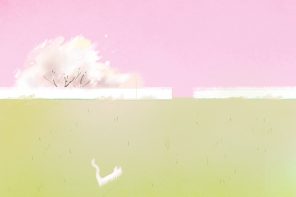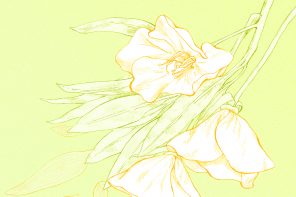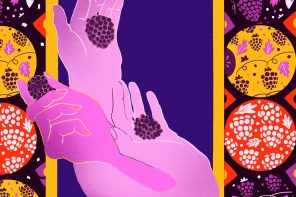In the beginning is mythology. A wide acceptance that the entitied and spectral are connected. Not a story of the creation of the world or the birth of a being from primeval slime. Not a god interfering with humanity or stealing a gorgeous mortal in the forest. I am asking us to start with just the idea that a human can also be more than her species, and that the moreness can extend us beyond the border of our bodies in time.
This is how the world holds us—spread between our own lives and the mythologies of others. One and many things. Visible only because nature has allowed us space in her vast wilderness.
In the birth story of our family, the child will be born of invention. A bundle of science and magic one day drawn out from the womb of one mother and placed in another. Before this, my partner and I, both women, went month after month to a clinic for inseminations, and I decided it was important to write things down. A child needs to know the landscape they will appear in. It’s the universe that dreams up the gods, not the other way around.
In my dreams, I collect the shimmers scattered on the journey from body to body, like a fish that jumps from ocean to estuary, scales bright enough to notify the trees of their greenness, to wake them to their own life. I am one of the bewitched organisms in waiting. And while I wait, I stabilize my roots, hold space in my bough, and merge with the landscape. I merge with the trees.
My name is Phyllis Hailey. I was named after my mother’s sister, Phyllis Hailey, who died shortly before I was born. The name “Phyllis” means leafy foliage, a green bough. In Greek myth, Phyllis marries Demophon. They meet while he’s travelling home from the Trojan War, and on the day after the wedding, he leaves her. He keeps travelling, as if their brief collision was only that, a still moment in his continuous kinetic journey. After a long wait for him to return, Phyllis hangs herself in an almond tree, but she doesn’t die. Instead, her body merges with the tree. The image I find on the Internet shows a woman whose legs are tree trunks with root-like feet. A woman whose arms are branches. Another image I find shows Phyllis unraveling from a tree swaddle, re-born of the same tree that she died in.
My aunt Phyllis was a painter. Most of her work was paintings of landscapes, trees. Patchy swaths of leaves take up the entire canvas in a blur of colors, as if the distinction of each leaf were too concrete, not accurate enough to the continuous expression of its treeness. Or to the expression of its other-than-treeness, the not-treeness that would be claimed by many of the abstract expressionist artists, disavowing that their paintings were actual references to things. Except, of course, for Joan Mitchell. Or, as Phyllis called her in letters, “Joan.” Phyllis lived with Mitchell in Vétheuil, a suburb of Paris. Mitchell was very clear about her own paintings. They were landscapes, landscapes of feelings. John Ashbery called them, “an unhurried mediation on bits of landscape and air.”
I think of Joan Mitchell’s work as an attempt to paint gesture. It’s both movement and capture, like the Greek Phyllis trapped forever after death in the life of a tree. Mitchell felt painting “never ends.” “It is,” she once said, “the only thing in the world which is both continuous and still.” The way I see it, the canvas and the painting are indistinguishable from each other, just like the woman and tree.
In April 1978, Phyllis Hailey got in the back seat of a Renault on her way to Florence, crashed into a tree, and the car burst into flames. The young painter, Hollis Jeffcoat, was in the car too. She rushed Phyllis to the hospital. Hollis misunderstood the doctor’s French and believed Phyllis had only a concussion. She called Joan who hurried to Phyllis’ bedside, bringing along a sketchbook. Surely, Phyllis would want to create, sitting around in a hospital bed. What else was there to do? But when Joan arrived, they learned Phyllis was essentially brain dead. Joan called my grandmother, and on April 9th, 1978, Phyllis died.
In the book that accompanied the 2002 Whitney exhibition of Mitchell’s work, one of the last paintings featured is L’Arbre de Phyllis (Phyllis’ Tree). She painted it in 1991, not long before her own death. It depicts a ginkgo tree in the fall. On the left side of the painting, yellows cover the canvas, stretched in every direction, becoming the canvas. As Mitchell once said about a similar work, “It’s a yellow painting. There’s hope.” But on the right side, dark blues are taken over by green bursts, yellow smudges, and toward the top of the canvas, cloud-like enjambment of blue and white seeps toward the right edge, the way light pastes on water, or fog covers trees. It’s a painting that captures a moment of transition, and the rendering makes it both static and continuous. A work that intimates Joan’s belief that “Phyllis is still painting in these hills.” A piece that believes in the collision of all things—Phyllis and the tree burst into flames together, and then later, she’s transformed, born of the tree that she dies with. The image of the ginkgo merges with Phyllis, who continues to live in color on canvas, the dizzying aura of a person who is no longer perceivable through our ordinary senses, but who is very much still here.
The ginkgo is an ancient tree, a gymnosperm, dating back to the early Jurassic period. It was around before the Atlantic Ocean existed, before the continental shift from Antarctica. It’s famous for its capacity to survive. Six ginkgo trees outlived the atomic bomb dropped on Hiroshima in 1945. The ginkgo survived all five mass extinctions, including the extinction two-hundred and fifty-one million years ago called “The Great Dying,” which wiped out ninety-six percent of the animals in the oceans. Consider this idea: there is no such thing as birth or death, only continuous energy. The ginkgo is a good example of this.
Patricia Albers, in her biography of Joan Mitchell, calls L’Arbre de Phyllis “shimmering” in a “light-intoxicated yellow.” She states: “Simultaneously a means of atonement, parting lesson, and ultimate sanctuary for the young painter, L’Arbre de Phyllis once again merges a tree with a person for whom Joan cared deeply.” Reading through my grandmother’s letters, I find a draft of a thank you note to Patricia Albers and realize that the only reason Phyllis is mentioned in the biography is because of the immaculate love and continued persistence of my grandmother.
I can always tell which paintings of Mitchell’s were from her time with Phyllis in the late 1970s because they look so similar to the paintings that hung on the walls of my childhood home. She has about four or five pieces all called Tilleul (Linden Tree) spanning from the late 1970s to her death in 1992. The 1978 version of Tilleul looks eerily similar to paintings Phyllis was making at the time. Droopy colors and rich dot-work, resembling the pregnant magnitude of fall, the leaves letting go. In 2005, my grandmother arranged a gallery show of Phyllis’ work in the mythic, full-scale replica of the Parthenon in Nashville, Tennessee, my hometown. Because Phyllis named so few of her paintings, my cousin Robert was tasked with naming them for the show. Robert is not a painter. He works for a semi-truck company. At the exhibit, we stood together looking at an untitled piece from my mother’s collection, one that hung on the wall in my childhood home, and Robert leaned over and said to me, “I decided to call it Tree.”
When Phyllis died, my parents decided to have a baby. To bring me to the forefront, to collect the light intoxicating shimmer of my being. When I was born, they tried to call me “Phyllis” in the hospital. Truly, they tried, but my grandmother couldn’t do it. To call me Phyllis carried that painful past into the present, so I was called “Hailey,” and the first few years of my life, my mother feared that I would die. I’d cough, and she’d immediately call the doctor. It’s likely that she was still actively grieving her sister through most of my early life. How could she not?
I ask my mom if she wants to read Phyllis’ letters. My Aunt Kay has dropped them off at the house. “They’re really amazing,” I tell her. “They capture her energy.” She replies, “I can’t.” Then looks me dead in the eyes, “I already know how incredible that girl is.”
It’s then that I realize Phyllis’ energy is not captured, but continuous, imprinted on me. It has survived her extinction. People like this, who create such energy, trace deeper than fossils.
My partner and I went for our third insemination on Labor Day weekend. We crossed our fingers, hoping that this time it would work. They gave us the usual paper, verifying our donor. They gave us the lab report on the vial. Total motility, total count, an exercise in accepting someone else’s current and allowing it to collide with my own. The insemination process is like a chemical reaction, a growing together of two vibrations, not like straight sex, which involves the clunky barrier of bodies. It’s like the male ginkgo’s pollen drop, drawn into the ovule of the female. Like the lava lamp bubble that bumps into the other. Like the woman who merges with the tree or the painting that merges with the canvas. I feel a creation already here, because it has always been here, in presence, before being formally presented to me.
Hailey Higdon’s work explores belonging and the boundaries of the self within the moving targets of community. She is the author of the poetry collection Hard Some (Spuyten Duyvil, 2019), as well as several small press chapbooks. Her writing appears most recently in Ruminate, Burnside Review, and Blazing Stadium. She is from Nashville. Find her online at haileyhigdon.com.




